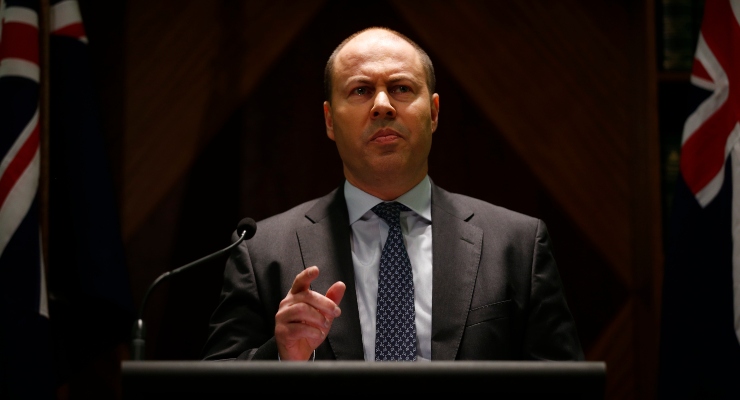
While Josh Frydenberg was keen to put an optimistic spin on Thursday’s mid-financial year budget update, much of the press gallery saw red — a budget deficit deep in the red.
Several commentators were alarmed by Treasury’s forecast increase in the government’s size (the percentage of GDP its spending occupies) even in the years after COVID expenses presumably wind down. Particular incredulity was raised at the once proudly frugal Coalition choosing to spend an unexpected increase in tax receipts instead of using it to pay down debt levels it once assured us were an economic and moral calamity.
The Nine papers called it a “spending explosion”. The ABC branded it a “massive debt bomb”. Crikey’s Bernard Keane wrote: “It further expands the size of government in Australia far above any previous levels since World War II … This is a profligate government that has expanded its spending addiction even further than previously.”
Keane eviscerated the hypocrisy of the government and its media allies presenting the Liberals as the party of small government when “Scott Morrison is Australia’s biggest taxing prime minister since John Howard”, and taxes and spending were both lower under the Rudd-Gillard government. The federal opposition and some progressive economists have struck similar notes.
These critics are right to note the government’s rhetorical inconsistencies on debt and the wastefulness of many of its schemes. But they are wrong insofar as they imply the government’s belated embrace of public spending is dangerous or unusual.
Compared with others, we aren’t big spenders…
The relevant comparison here is not with previous Australian governments who faced different economic circumstances; it is with what similar countries are doing. And in this context Australia hardly looks like a reckless anomaly.
Government spending is just a bit above the OECD average; our debt is also just a little above average.

If we look to what our peer nations are planning for the years ahead, our ambitions seem mild. The Biden administration is pushing against the intransigence of rogue Democrats to pass another mammoth spending bill. In the UK, public spending hit 52% of GDP last financial year. Chancellor Rishi Sunak is being urged to again exceed his former commitment of 37% to cushion the economy against Omicron. By contrast, Australia’s is projected to be 27-29% for 2021-25.
…but our taxes are abnormally low
We have recently jumped into the top quarter of OECD nations for largest deficits (the balance of income and expenditure). First, this isn’t cause for alarm — we can handle it. Second, this is largely due to us having the sixth-lowest tax take in the OECD — with more irresponsible and inegalitarian tax cuts on the way.

This is rarely noted by the mainstream press that frequently use pejorative terms like “burden” to stigmatise already anaemic revenue streams. Neither does it seem of much concern to the political class’ go-to economists like Ken Henry, who simultaneously opine about out-of-control public finances while backing the government’s tax cuts for high earners.
But they have it backwards: our spending is thoroughly ordinary, while our taxation levels are unusually low.
Frydenberg deserves credit where it’s due
The fact that the Liberals and half the press gallery lean on tired tropes about who the superior “economic managers” are — even when said managers don’t live up to their own supposed standards — is galling, and it impoverishes our public debate. But we mustn’t let the partisan zeal of a “gotcha” moment on Liberal hypocrisy entrench regressive and inaccurate narratives about our nation’s public finances.
It is not Frydenberg who is being fiscally reckless; it was his predecessors such as Joe Hockey who clung to “small government” dogma and refused to raise sufficient revenue to fund the services and infrastructure communities needed.
And Labor’s economic pride should not be tethered to its record of lower taxing and spending; it should be derived from its relative willingness to tax and spend what’s necessary to combat social problems and economic crises.
Given the lateness of his Keynesian conversion, I don’t trust Frydenberg to stay the course, especially as others in his party pressure him to return to a “fiscal conservative position”. Nor do I trust Morrison’s team to reliably direct funds to public interest projects. But for now he has sensibly moved the Coalition’s position from cutting its way to surplus to growing its way there.
If that line keeps trending in the right direction, who knows… we might reach “responsible taxation” by 2025.








Do you know what else “impoverishes our public debate”? Accepting the neoliberal tropes that the federal government is like a household, and must “live within its means”.
Whether the economy is in surplus or deficit is not the meaningful metric: the government can no more run short of dollars than Coles can run out of Fly-Buys. (That is not to say the government should spend endlessly, only that it is not limited in any way by its tax take. There are no purely financial constraints, only real resource constraints. The size of the economy is limited by the availability of real goods and services in it that can be produced. Spending – whether public or private – beyond that point is what causes inflation, not the quantity of money on issue.)
What really matters is inflation and unemployment. The macroeconomic levers should be operated to achieve getting both of those figures down to between 1-2%. Do that, and all the other problems solve themselves.
Absobloodylutely!!! Thank you!
It’s not enough to measure the amount of money flowing out the door (although at least that’s easy). You have to look at how effectively it’s being spent. On desirable social outcomes. While we might be in the middle of the pack on expenditure, we know (thanks to Crikey) that most of it is flowing straight into the pockets of donors, and none is being allocated on the basis of any kind of measurable merit or according to any kind of plan (besides re-election). Governing for their “mates” only. That’s not “big government”, that’s crony-capitalism of banana-republic proportions.
It doesn’t matter a rat’s bum hairs about total tax and spending. It’s all about what the money is spent on. While we have people sleeping rough and dying of preventable diseases, and kids missing school and growing up disfunctional, and overflowing prisons, then what money there is is being spent on the wrong things. It’s NOT OK. The graphs are rubbish.
No, he isn’t into “Big Government” where it counts. Nearly all of that GDP spend is going out in subsidies and payouts to Liberal Party donors……not to the millions of ordinary Australians who actually need a leg up.
In the face of stagnated wage growth and massive wastage of public money (rorts, white elephants, fossil fuel subsidies, job keeper theft) the path to ‘growth’ will almost certainly come in the form of a resumption of rapid mass immigration, both permanent and temporary. Show me where a LNP government has ever lowered unemployment by spending on essential socially beneficial programs.
To be honest, if you used OECD (source of the chart in the article) long term permanent workforce data i.e. ex. NOM temporary churn over (of mostly students on restricted work rights & net financial budget contributors), Australia is like anywhere else.
We have an ageing population, workforce participation and/or working age has passed the sweet spot, while we have increased dependency ratios due to more retirees/pensioners, tugging on budgets, but catered to by both parties, especially the LNP.